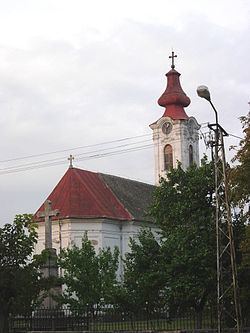Demonym(s) novobečejci, (sr) Postal code 23272 Area 609 km² Local time Monday 2:17 PM | District Central Banat Time zone CET (UTC+1) Area code(s) +381(0)23 Population 13,133 (2011) | |
 | ||
Weather 19°C, Wind NW at 18 km/h, 44% Humidity | ||
Novi Bečej (Serbian Cyrillic: Нови Бечеј), is a town and municipality located in the Central Banat District of the autonomous province of Vojvodina, Serbia. The town has a population of 13,133, while Novi Bečej municipality has 23,925 inhabitants.
Contents
- Map of Novi BeC48Dej Serbia
- Name
- History
- Inhabited places
- Ethnic groups in the Novi Beej municipality
- Ethnic groups in the Novi Beej town
- Historical population of the town
- Economy
- Culture
- Araa
- Slano Kopovo
- Notable citizens
- Twin cities
- References
Map of Novi Be%C4%8Dej, Serbia
Name
Novi Bečej means "new Bečej". In the past it was known as Turski Bečej (Турски Бечеј, "Turkish Bečej"), while the current town of Bečej, across the river Tisa (in the Bačka region) was in the past known as Stari Bečej (Стари Бечеј, "old Bečej") and today is known as Bečej.
There are several theories about town's name origin. The first one is that it derives from Castellum de Beche, which was the name of the fort located near today's town center. The other theory is that the name was given after the family Wechey, which used rule the settlement and the land around modern-day Novi Bečej. The town was also known as Turski Bečej (Турски Бечеј). In 1919 it was renamed Novi Bečej (Нови Бечеј). For a short period of time after the World War II the name of the town was Vološinovo / Волошиново after Red Army Colonel Laverentiĭ Voloshinov who died in the battle for the liberation of the town. The name Novi Bečej has been in official use since 1952.
In Serbian, the town is known as Novi Bečej (Нови Бечеј), in Hungarian as Törökbecse and in German as Neu-Betsche. Both Serbian and Hungarian are officially used by municipal authorities.
History
12th century BC ornithomorphic pendants were found in the town. The Dacians inhabited the region before the Roman conquest in the 2nd–1st century BC.
The town was first mentioned in 1091 during the administration of the Kingdom of Hungary. In the 15th century, it was a possession of the Serbian despot Đurađ Branković. During the Ottoman rule (in 1660/6), it was populated by ethnic Serbs. Ottomans administered the town as Beçe from 1552 to 1718. Until 1918, it was part of the Habsburg Monarchy, then part of the Kingdom of Serbs, Croats and Slovenes and subsequent South Slavic states.
Inhabited places
Novi Bečej municipality includes the town of Novi Bečej and the following villages:
Ethnic groups in the Novi Bečej municipality
According to the 2011 census, the Novi Bečej municipality has 23,925 inhabitants, including:
All settlements in the municipality have an ethnic Serb majority.
Ethnic groups in the Novi Bečej town
The town of Novi Bečej had 13,133 inhabitants, including:
Historical population of the town
Economy
There are several factories operating in Novi Bečej, but the leading branch of economic development is tourism. The town is located on the river Tisa, and thus it offers many leisure opportunities.
Main employers are:
Culture
Serbia's fourth largest festival, Velikogospojinski Dani ("Dormition Days"), is held in Novi Bečej. The festival honors the town's patron saint, Mary. It gathers more than 200,000 visitors from across Serbia and surrounding areas. Most popular Serbian, Croatian, and Hungarian singers and bands, such as Lepa Brena, Zdravko Čolić, Severina, Tony Cetinski, Crvena Jabuka, Plavi Orkestar, Željko Joksimović, Edda, Omega, etc. have performed here. Also, great historical legacy is a big boost, since there are remains of a medieval monastery Arača and the old fort.
Arača
Arača, is a medieval Romanesque church ruin about 12 km north of Novi Bečej. It is the one of the older churches built in the region during administration of the Kingdom of Hungary. The Department for the Protection and Scientific Study of Cultural Monuments in Belgrade issued a decision in 1948 which placed the Romanesque church of Arača under state protection.
The church was built around 1230, robbed and devastated in 1280, and reconstructed in 1370 at the command of Queen Elizabeth. The Gothic tower that is still extant today probably dates from this time. In the year 1417 it came into possession of Serbian despot Stefan Lazarević. Later it belonged to the Serbian despot Đurađ Branković who gave it as a present to Pál Birinyi. In the year 1551, the Ottomans burned the cathedral down and it was never reconstructed again. At the end of the 18th century it belonged to Sissány family.
Slano Kopovo
Slano Kopovo is located in the northeast of Novi Bečej and near the river Tisa. It is one of the last preserved salt marshes in Serbia. It features unique Pannonian habitats typified by salty, muddy ponds and lakes or their occasionally dry beds. Slano Kopovo is a priceless centre of salt-marsh habitats which is threatened with complete disappearance.
The significance of Slano Kopovo is manifold. It is one of the most important and unique bird habitats in Serbia. It is of particular value in that species are found nesting here which are typical of the Ponto-Caspian and sea coasts and not of the Pannonian Plain. This is also a unique stopover point for migratory bird species. With the Tisa close by, species which follow the course of this river and its forest belt readily alight on this wide, open water surface. Slano Kopovo is a favourable environment for cranes, ducks, geese and waders as well as Pied Avocet and Kentish Plover. 203 bird species have been recorded at Slano Kopovo, which is 63% of all the known species in Vojvodina.
